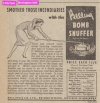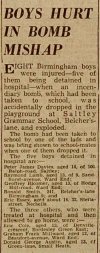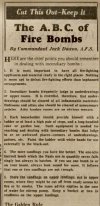-
Welcome to this forum . We are a worldwide group with a common interest in Birmingham and its history. While here, please follow a few simple rules. We ask that you respect other members, thank those who have helped you and please keep your contributions on-topic with the thread.
We do hope you enjoy your visit. BHF Admin Team
You are using an out of date browser. It may not display this or other websites correctly.
You should upgrade or use an alternative browser.
You should upgrade or use an alternative browser.
Incendiary bombs across Birmingham
- Thread starter Phil
- Start date
Eric Gibson
master brummie
A wartime tool for snuffing out incendiary bombs? E.
motorman-mike
Brum visitor who stayed.
That's interesting Phil, I have only ever seen pics of them being sprayed with water from a stirrup pump or having sand shovelled over them.
Mike.
Mike.
V
Vintage Brumie
Guest
Re: ... spraying incendary bombs with water ... NO WAY. That was the worst thing one could do ! Incendary bombs were made of phosphorus which - if sprayed with water - would burn with greater intensity and quickly explode.That's interesting Phil, I have only ever seen pics of them being sprayed with water from a stirrup pump or having sand shovelled over them.
Mike.
coopbill7
very old brummie
Re: ... spraying incendary bombs with water ... NO WAY. That was the worst thing one could do ! Incendary bombs were made of phosphorus which - if sprayed with water - would burn with greater intensity and quickly explode.
Vintage Brumie.
Ive answered your instant message,but it states that you do not or can not receive instant messages!!!!! this is the only way I can contact you
Peter
Frothblower
Lubrication In Moderation
Putting-out 6 giant candles...........
You were close with the candles Mab LOL
davidfowler
Exiled Brummie
[ame="https://www.youtube.com/watch?v=_YV36kYEfFk"]YouTube - Abbott & Costello show how NOT to put out an Incendiary Bomb[/ame]
Richard Dye
master brummie
That 20% tax on those other parts is quite high!Here's another bomb snuffer. Can't say I'd want to use one, but suppose needs must in WW2. Does anyone remember having one of these left over from wartime?
Source: British Newspaper Archive View attachment 188838
Pedrocut
Master Barmmie
(Birmingham Gazette January 1941.)
FIRE BOMB TECHNIQUE…Thousands of people will soon be dealing with fire bombs for the first time. The upper picture shows how to enter a burning room. Keep near the floor: The air is fresher. Remember, too, that when the door is opened flames and smoke may fly out into the face. stirrup If you have no stirrup pump and need to approach the bomb, hold a half-filled sandbag to upper part of the face and body.
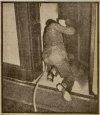
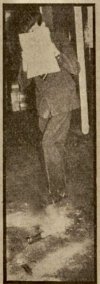
FIRE BOMB TECHNIQUE…Thousands of people will soon be dealing with fire bombs for the first time. The upper picture shows how to enter a burning room. Keep near the floor: The air is fresher. Remember, too, that when the door is opened flames and smoke may fly out into the face. stirrup If you have no stirrup pump and need to approach the bomb, hold a half-filled sandbag to upper part of the face and body.


We had an incendiary bomb fall on our shop in Slade Road in Erdington. It went through the roof, burnt through the ceiling in my Dad's bedroom, through his bed and then through the floor to the room below, which had a stone floor. Fortunately for me and for my Dad (who was still at school then) he was sheltering in the cellar with my Nan. My grandad (who was an ARP) was called to put the fire out, at his own shop! The marks in the two ceilings, where they had been plastered over, were still visible when we left the shop some 45 years later.
Eric Gibson
master brummie
My grandma had one into the loft in Barton's Bank, it didn't immediately go off so she grabbed it and chucked it into the yard 
British and American incendiaries were made of phosphorous. - You can use water to quench phosphorous, but you have to be very careful it does not spread the phosphorous particles since they will reignite when the water drys out. The Germans used Thermite in their smaller incendiaries, which would explode with a steam explosion if water was poured on it. The Germans had two types of small incendiary they used against Britain, the 1 Kg bomb was a pure incendiary, while the 2Kg had an explosive charge to spread the fire. Both could be fitted with a heavy "tile breaker" head to penetrate into the roof of houses. The Germans also had the fearsome Flam 500 - called the "Oil Bomb" by the British- essentially a crude form of Napalm. This was much larger and devastating if it worked. Thankfully it was a very unreliable in use and a lot of them did not ignite.Re: ... spraying incendary bombs with water ... NO WAY. That was the worst thing one could do ! Incendary bombs were made of phosphorus which - if sprayed with water - would burn with greater intensity and quickly explode.
Edit - turns out the British didn't use phosphorous incendiaries, we used Thermite like the Germans. However, the British did use Phosphorus for target-marking flares and to create smoke screens.
Last edited:
pjmburns
master brummie
John L needs to change his settings to "allow conversation". Then you can contact him by clicking on his name (next to his avatar) and "start conversation".
Or you can use the envelope top right of the page and enter his name.
Neither will work until he has changed his settings.
Or you can use the envelope top right of the page and enter his name.
Neither will work until he has changed his settings.
pjmburns
master brummie
John L has now changed settings so you can converse with him as indicated in the previous post.I would be glad if someone can remind me how to contact a particular person, as I would like more info. from John L about he shop he mentions in #20 , so that any conversation we have does not become distraction from the thread. Thanks.
I have sent him a message. Thanks for mentioning what I needed to do.John L has now changed settings so you can converse with him as indicated in the previous post.


